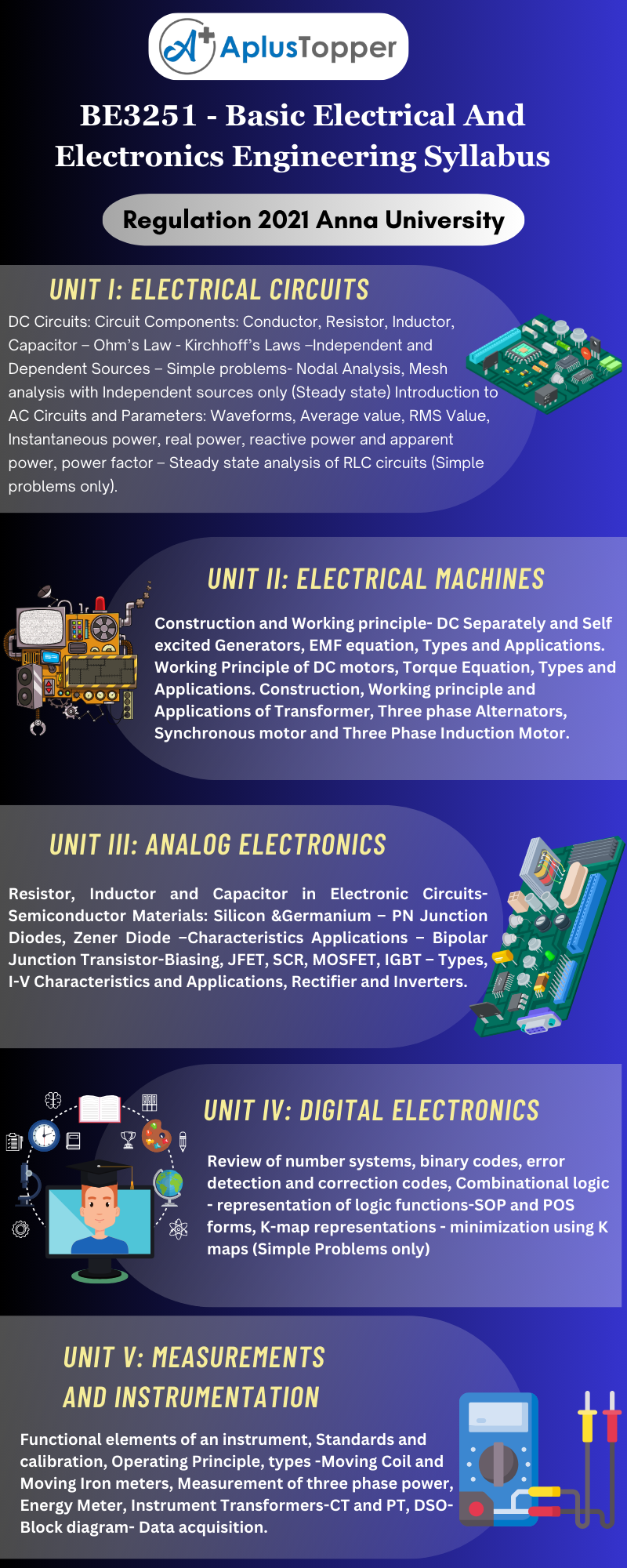Regulation 2021 Anna University Code – BE3251 deals with the semester – II Basic Electrical And Electronics Engineering Syllabus of B.E Mechanical Engineering. Most of the semester syllabus tries to give both practical and theoretical knowledge to the students. To acquire the proper knowledge regarding the studies to prepare for the examination, need a detailed syllabus right?
This article will assist you in gaining most of the syllabus details. We tried our best to provide the required syllabus info. Chapter-wise syllabus along with reference books written by experts and textbooks added. Hence in this article Code BE3251 – Basic Electrical And Electronics Engineering syllabus, we include all the details regarding the examination. Students can easily get all the data regarding the syllabus on one page. Hope you will understand the syllabus. And All the best for your exams. Don’t forget to share it with your friends.
If you want to know more about the syllabus of B.E Mechanical Engineering connected to an affiliated institution’s four-year undergraduate degree program. We provide you with a detailed Year-wise, semester-wise, and Subject-wise syllabus in the following link B.E Mechanical Engineering Syllabus Anna University Regulation 2021.
Aim Of Objectives:
- To introduce the basics of electric circuits and analysis
- To impart knowledge in the basics of working principles and application of electrical machines
- To introduce analog devices and their characteristics
- To educate on the fundamental concepts of digital electronics
- To introduce the functional elements and working of measuring instruments
BE3251 – Basic Electrical And Electronics Engineering Syllabus
Unit I: Electrical Circuits
DC Circuits: Circuit Components: Conductor, Resistor, Inductor, Capacitor – Ohm’s Law – Kirchhoff’s Laws –Independent and Dependent Sources – Simple problems- Nodal Analysis, Mesh analysis with Independent sources only (Steady state) Introduction to AC Circuits and Parameters: Waveforms, Average value, RMS Value, Instantaneous power, real power, reactive power and apparent power, power factor – Steady state analysis of RLC circuits (Simple problems only).
Unit II: Electrical Machines
Construction and Working principle- DC Separately and Self-excited Generators, EMF equation, Types and Applications. Working Principle of DC motors, Torque Equation, Types and Applications. Construction, Working principle and Applications of Transformer, Three phase Alternators, Synchronous motor and Three Phase Induction Motor.

Unit III: Analog Electronics
Resistor, Inductor and Capacitor in Electronic Circuits- Semiconductor Materials: Silicon &Germanium – PN Junction Diodes, Zener Diode –Characteristics Applications – Bipolar Junction Transistor-Biasing, JFET, SCR, MOSFET, IGBT – Types, I-V Characteristics and Applications, Rectifier and Inverters.
Unit IV: Digital Electronics
Review of number systems, binary codes, error detection and correction codes, Combinational logic – representation of logic functions-SOP and POS forms, K-map representations – minimization using K maps (Simple Problems only).
Unit V: Measurements And Instrumentation
Functional elements of an instrument, Standards and calibration, Operating Principle, types -Moving Coil and Moving Iron meters, Measurement of three-phase power, Energy Meter, Instrument Transformers-CT and PT, DSO- Block diagram- Data acquisition.
Text Books:
- Kothari DP and I.J Nagrath, “Basic Electrical and Electronics Engineering”, Second Edition, McGraw Hill Education, 2020
- S.K. Bhattacharya “Basic Electrical and Electronics Engineering”, Pearson Education, Second Edition, 2017.
- Sedha R.S., “A text book of Applied Electronics”, S. Chand & Co., 2008
- James A. Svoboda, Richard C. Dorf, “Dorf’s Introduction to Electric Circuits”, Wiley, 2018.
- A.K. Sawhney, Puneet Sawhney ‘A Course in Electrical & Electronic Measurements & Instrumentation’, Dhanpat Rai and Co, 2015.
References:
- Kothari DP and I.J Nagrath, “Basic Electrical Engineering”, Fourth Edition, McGraw Hill Education, 2019.
- Thomas L. Floyd, ‘Digital Fundamentals’, 11th Edition, Pearson Education, 2017.
- Albert Malvino, David Bates, ‘Electronic Principles, McGraw Hill Education; 7th edition, 2017.
- Mahmood Nahvi and Joseph A. Edminister, “Electric Circuits”, Schaum’ Outline Series, McGraw Hill, 2002.
- H.S. Kalsi, ‘Electronic Instrumentation’, Tata McGraw-Hill, New Delhi, 2010
Related Posts On Semester – II:
- HS3252 – Professional English – II
- MA3251 – Statistics and Numerical Methods
- PH3251 – Materials Science
